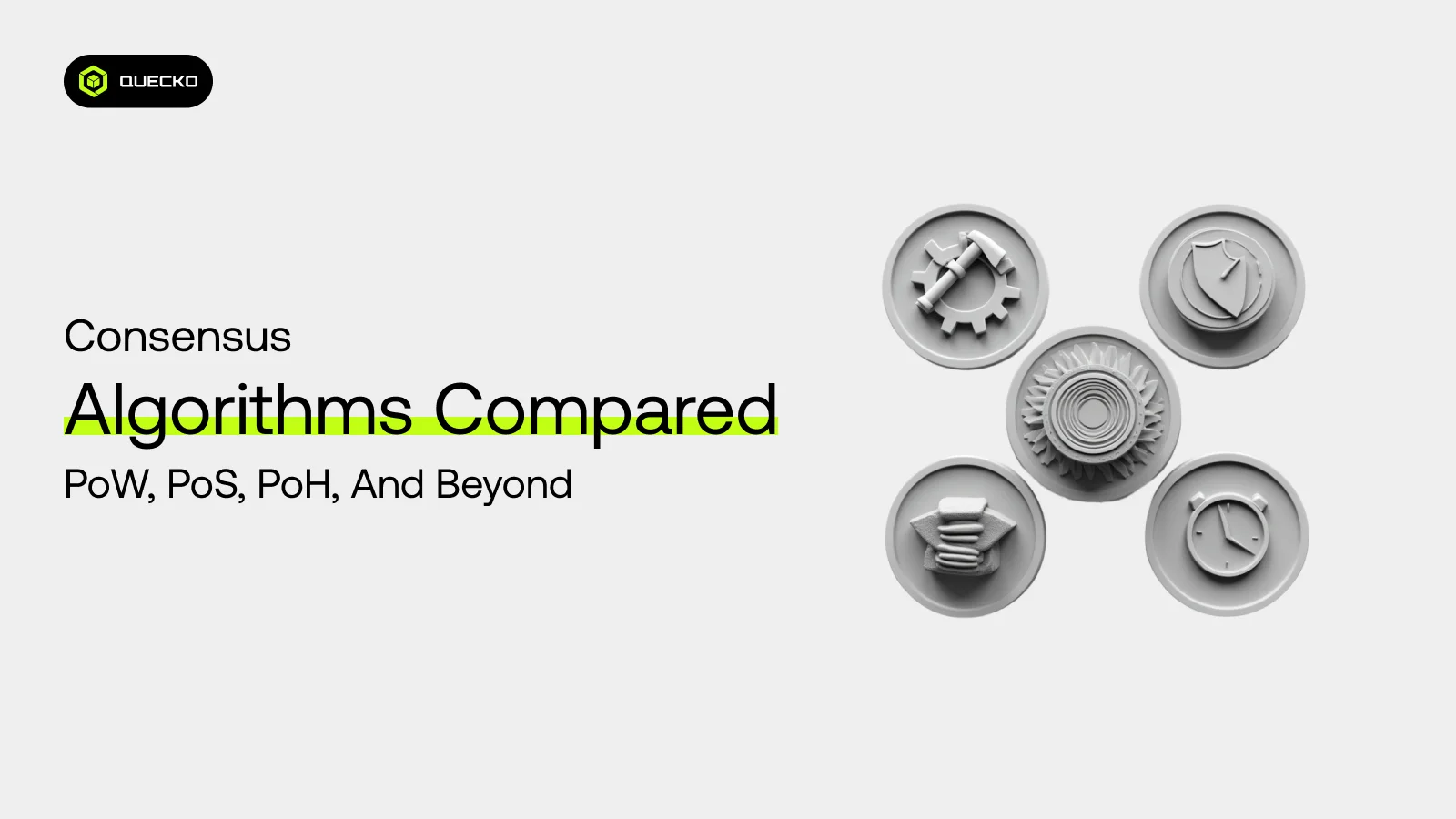Consensus Algorithms Compared: PoW, PoS, PoH, and Beyond
Compare PoW, PoS, PoH & other consensus algorithms—security, scalability, and energy use explained.

Consensus algorithms are the backbone of blockchain networks, ensuring that all network participants reach agreement on the validity of transactions without reliance on a central authority like banks or financial institutions. Unlike traditional systems that depend on intermediaries to process transactions—such as debit cards requiring verification from financial entities—blockchains establish trust through mathematical rules and cryptographic validation.
Each block of transactions must undergo rigorous verification, which varies depending on the consensus mechanism used. Models like Proof of Work (PoW) demand high mathematical computation, leading to substantial energy consumption and increased transaction fees due to mining competition. Meanwhile, Proof of Stake (PoS) offers a more efficient approach, reducing costs and improving speed by selecting validators based on their stake in the network. Emerging solutions like Proof of History (PoH) further refine transaction sequencing, boosting efficiency and minimizing scalability issues.
As blockchain technology evolves, new consensus mechanisms aim to balance decentralization, security, and cost-effectiveness. This blog explores key models, examining their strengths, weaknesses, and future implications for decentralized ecosystems.
Proof of Work (PoW)
Proof of Work (PoW) is a popular consensus algorithm first introduced by Bitcoin in 2008 by Satoshi Nakamoto. It remains a foundational method for securing public blockchains within the broader blockchain network. PoW relies on miners who must solve complex cryptographic puzzles to validate transactions and create new blocks, ensuring integrity and decentralization.
In decentralized networks, PoW plays a crucial role in preventing fraudulent activities and securing transactions without requiring trust in a central authority. The consensus process involves miners competing to solve mathematical problems, with the first successful miner earning the right to add a new block to the ledger. As a result, PoW ensures fairness and transparency while maintaining network security.
Despite its reliability, PoW faces challenges related to energy efficiency, as the computational power required for mining demands significant electricity consumption. Unlike newer models that prioritize sustainability, PoW remains resource-intensive, prompting discussions about alternative methods. While PoW doesn’t directly involve token holders in the validation process, it creates incentives through mining rewards, reinforcing network participation.
Mechanics
- Mining Competition: In PoW, miners compete to find a nonce that, when hashed, produces a value below a predefined target threshold. This process ensures transaction security but requires immense computational effort, leading to discussions about environmental payments to offset energy consumption.
- Difficulty Adjustment: To maintain a faster transaction process and prevent excessive delays, the network dynamically adjusts puzzle difficulty based on the mining speed. This adaptation helps optimize transaction throughput, ensuring the blockchain can process a steady number of transactions efficiently.
- Longest Chain Rule: In PoW, the chain with the most cumulative work is considered valid, preventing attacks or forks from overtaking the network. While PoW is highly secure, researchers are exploring acidic solution methodologies to make mining processes more energy-efficient and sustainable.
Pros
✅ High Security: Extremely resistant to attacks (51% attacks are costly).
✅ Decentralization: Anyone with computational power can participate.
Cons
❌ Energy Intensive: High electricity consumption (e.g., Bitcoin uses ~150 TWh/year).
❌ Slow Transactions: Limited scalability (~7 TPS for Bitcoin).
Use Cases
- Bitcoin (BTC)
- Litecoin (LTC)
- Ethereum (pre-merge)
Proof of Stake (PoS)
Proof of Stake (PoS) was proposed as an energy-efficient alternative to PoW networks, eliminating the need for intensive computational power by selecting validators based on the amount of cryptocurrency they “stake” as collateral. Unlike PoW, which relies on mining competitions, PoS ensures security through economic incentives, reducing the environmental impact associated with traditional consensus mechanisms.
Validators operate within a network of nodes, collectively verifying transactions and maintaining integrity. The consensus protocol prevents malicious nodes from manipulating the system while efficiently handling faulty nodes that may disrupt operations. This setup enhances security while reducing computational costs, making PoS a preferred choice for scalability-focused blockchain applications.
A comparative analysis between PoW and PoS highlights key differences, particularly in energy consumption, decentralization, and transaction processing speed. While PoW demands heavy computational work, PoS optimizes resource usage, allowing for a streamlined experience in digital payments, including integrations with payment terminals and financial infrastructures.
In real-world applications, PoS networks enable seamless integration with sales systems, supporting businesses looking for secure and efficient blockchain-based solutions. Advanced cryptographic methods, such as negative logarithms, contribute to enhanced mathematical modeling within blockchain security, further reinforcing trust among participants.
Mechanics
- Staking: Users participate in the network by locking up a certain amount of cryptocurrency as collateral, making them eligible to become validators. The more coins a user stakes, the higher their chances of being selected. This process not only secures the network but also aligns incentives, ensuring validators act honestly to protect their investments.
- Random Selection: Validators are chosen through a pseudo-random selection process, which takes into account factors like stake size, staking duration, and additional network-defined criteria. Unlike Proof of Work (PoW), where miners compete using computational power, PoS eliminates unnecessary resource consumption, leading to a more energy-efficient consensus mechanism.
- Slashing: To prevent fraud and encourage honest behavior, PoS implements a slashing penalty where malicious validators lose a portion or all of their staked funds if they attempt to manipulate transactions or act dishonestly. This ensures network integrity while discouraging attacks like double-spending or invalid block proposals.
Pros
✅ Energy Efficient: No mining required.
✅ Faster Transactions: Higher throughput (e.g., Ethereum 2.0: ~100,000 TPS with sharding).
Cons
❌ Wealth Centralization: Rich stakeholders have more influence.
❌ Security Risks: “Nothing at Stake” problem (validators may support multiple chains).
Use Cases
- Ethereum 2.0 (ETH)
- Cardano (ADA)
- Polkadot (DOT)
Proof of History (PoH)
Proof of History (PoH) was introduced by Solana as an innovative approach to improving scalability in public blockchain networks. By using cryptographic timestamps, PoH ensures that transactions are ordered before reaching consensus, reducing processing time and enhancing efficiency. Unlike traditional consensus mechanisms that require sequential validation, PoH enables parallel verification, making it ideal for high-speed transaction environments.
In contrast to mathematical puzzles used in Proof of Work (PoW), which demand extensive computational resources, PoH relies on verifiable time delays, significantly increasing throughput while reducing energy consumption. This efficiency benefits various applications, including mobile payments, where instant processing is crucial for user experience. Additionally, businesses integrating blockchain technology for credit card transactions can leverage PoH’s speed to enhance payment security and reliability.
Token holders in PoH-based networks still play a vital role in governance and validation, ensuring that the system remains decentralized and fair. However, like all blockchain protocols, PoH must address risks associated with malicious actors, who may attempt to manipulate transaction sequencing or disrupt network integrity. Security measures within Solana’s framework help mitigate these threats, reinforcing trust in the system’s functionality.
Mechanics
- Verifiable Delay Function (VDF): The VDF serves as a crucial component in ensuring a historical record that proves time has passed in a blockchain network. It functions by requiring a sequential computation that cannot be parallelized, making it resistant to manipulation and ensuring fair ordering of transactions. This mechanism enhances security by preventing malicious actors from reordering transactions or influencing consensus unfairly.
- Leader Rotation: To maintain network efficiency and decentralization, blockchain systems use leader rotation, where a designated leader sequences transactions and proposes blocks. Other validators in the network then confirm and validate the proposed transactions to ensure accuracy. This rotation process prevents centralization by distributing authority among different nodes, ensuring fairness and reducing vulnerabilities from a single point of failure.
- Turbine Protocol: The Turbine Protocol is designed to improve blockchain scalability by splitting data into smaller packets for faster propagation across the network. Instead of broadcasting entire blocks at once, this method divides the information and sends it in smaller chunks, allowing nodes to process data more efficiently. This technique significantly enhances transaction speed, making blockchain networks more suitable for high-volume applications such as decentralized finance (DeFi) and gaming.
Pros
✅ High Throughput: Solana claims ~65,000 TPS.
✅ Low Latency: Fast finality (~400ms block times).
Cons
❌ Centralization Risks: Relies on high-performance nodes.
❌ New & Untested: Less battle-tested than PoW/PoS.
Other Consensus Mechanisms
Delegated Proof of Stake (DPoS) DPoS enables stakeholders to vote for trusted delegates who validate transactions on their behalf, ensuring a more efficient decision-making process. The limited number of validators allows faster block production, enhancing network performance. Examples: EOS, Tron Pros: Faster transaction speeds, highly scalable, and promotes community governance. Cons: More centralized due to a smaller number of validators, potentially reducing decentralization over time.
Proof of Authority (PoA) PoA operates using identity-based validation, meaning only pre-approved nodes can propose and verify blocks, making it a highly controlled system. It is best suited for enterprise applications where security and efficiency are prioritized over decentralization. Examples: Binance Smart Chain (BSC)
Pros: High transaction throughput, minimal energy consumption, and predictable network stability.
Cons: Centralized structure limits participation and requires trust in selected validators, making it less decentralized.
Proof of Burn (PoB) PoB offers an alternative mining mechanism where participants “burn” coins, permanently removing them from circulation in exchange for mining rights. This discourages inflation while ensuring commitment from network participants. Examples: Slimcoin
Pros: No hardware waste, lowers environmental impact, and adds long-term commitment from miners.
Cons: Economically inefficient, as burning coins may reduce liquidity and market participation.
Directed Acyclic Graph (DAG) DAG eliminates traditional block structures, allowing transactions to confirm one another without sequential block production. This enables faster validation and near-instantaneous processing, making it ideal for microtransactions and IoT applications. Examples: IOTA, Nano
Pros: Highly scalable, low fees or feeless transactions, and decentralized transaction verification.
Cons: Security trade-offs due to a lack of traditional consensus methods, potentially making networks more vulnerable to attacks.
Each of these consensus mechanisms caters to different blockchain needs, offering unique advantages and trade-offs.
Comparison Table
| Algorithm | Security | Scalability | Energy Use | Decentralization |
| PoW | High | Low | Very High | High |
| PoS | Medium | High | Low | Medium |
| PoH | Medium | Very High | Low | Low-Medium |
| DPoS | Medium | High | Low | Low |
| PoA | Low-Medium | High | Very Low | Very Low |
Future Trends
The future of blockchain consensus is rapidly evolving as networks seek to balance security, efficiency, and scalability. Hybrid Models, such as combinations of Proof of Work (PoW) and Proof of Stake (PoS), are emerging to leverage PoW’s security while integrating PoS’s energy efficiency and speed. These hybrid approaches aim to reduce energy consumption while maintaining decentralized trust.
Quantum-Resistant Consensus is becoming increasingly important as advancements in quantum computing pose potential risks to traditional cryptographic security. Researchers are developing algorithms resistant to quantum attacks, ensuring blockchain networks remain secure against future technological threats.
Sharding & Layer 2 Solutions are redefining scalability by enabling parallel transaction processing. Sharding divides the blockchain into smaller, more manageable segments (shards), allowing multiple transactions to be verified simultaneously. Meanwhile, Layer 2 solutions, such as roll-ups and sidechains, operate on top of main blockchains to alleviate congestion and reduce fees, paving the way for mass adoption of decentralized applications.
These innovations will continue shaping blockchain technology, making networks more adaptable, efficient, and secure for widespread use across industries.
Conclusion
Each consensus algorithm offers unique advantages and trade-offs, shaping the way blockchain networks function. Proof of Work (PoW) remains one of the most secure mechanisms but is increasingly criticized for its unsustainable energy consumption and high computational demands. Proof of Stake (PoS) strikes a balance between efficiency and security by selecting validators based on their stake, reducing environmental impact while maintaining decentralization.
Proof of History (PoH) enhances throughput by introducing cryptographic timestamps to sequence transactions before consensus, but its experimental nature means it requires further optimization. Newer models like Delegated Proof of Stake (DPoS), Proof of Authority (PoA), and Directed Acyclic Graph (DAG) focus on specific use cases, prioritizing factors like speed, governance efficiency, or scalability.
Looking ahead, hybrid approaches are likely to shape the future of blockchain, combining multiple models to maximize security, decentralization, and transaction processing speed. Additionally, scalability improvements, such as sharding and Layer 2 solutions, will enable blockchain networks to support a higher volume of transactions without sacrificing performance. As the industry evolves, the challenge remains in refining these mechanisms to ensure adaptability, security, and widespread adoption.
Date
3 months agoShare on
Related Blogs

How Blockchain Is Disrupting Traditional Banking Systems
10 days ago

AI-Powered Smart Contract Wallets The Future of User-Friendly Blockchain UX
15 days ago

Using NFTs for Brand Loyalty: The Next Big Marketing Shift
16 days ago

How Tokenized Real-World Assets Are Reshaping Finance in 2025
17 days ago








